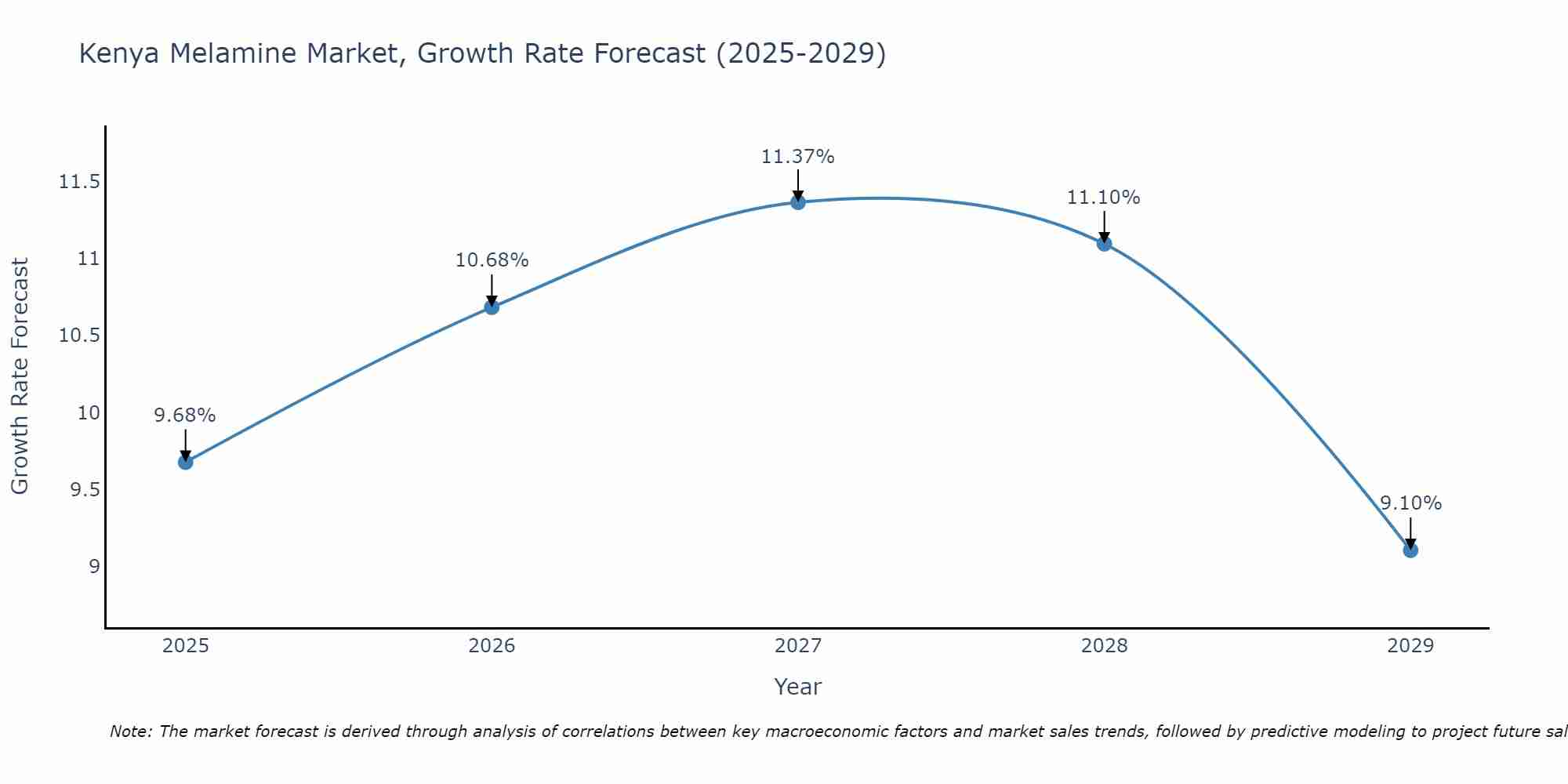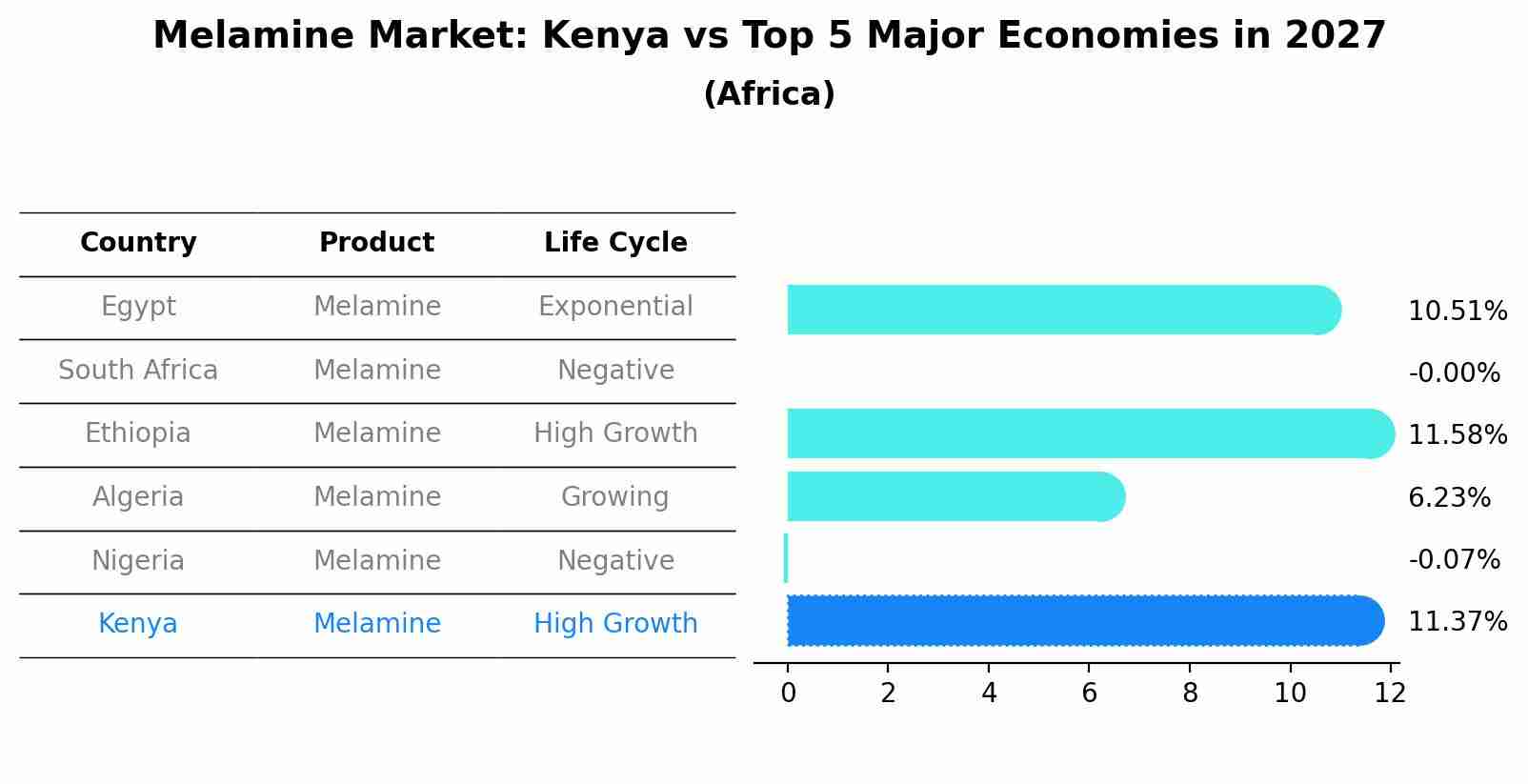Kenya Melamine Market Outlook | Size, Value, Companies, Trends, Forecast, Analysis, COVID-19 IMPACT, Industry, Growth, Revenue & Share
| Product Code: ETC092049 | Publication Date: Jun 2021 | Updated Date: Jun 2025 | Product Type: Report | |
| Publisher: 6Wresearch | Author: Bhawna Singh | No. of Pages: 70 | No. of Figures: 35 | No. of Tables: 5 |
Kenya Melamine Market Size Growth Rate
The Kenya Melamine Market is projected to witness mixed growth rate patterns during 2025 to 2029. Starting at 9.68% in 2025, the market peaks at 11.37% in 2027, and settles at 9.10% by 2029.

Melamine Market: Kenya vs Top 5 Major Economies in 2027 (Africa)
By 2027, the Melamine market in Kenya is anticipated to reach a growth rate of 11.37%, as part of an increasingly competitive Africa region, where Egypt remains at the forefront, supported by South Africa, Ethiopia, Algeria and Nigeria, driving innovations and market adoption across sectors.

Kenya Melamine Market Overview
The Kenya Melamine Market is experiencing steady growth driven by the increasing demand for melamine-based products in various industries such as construction, automotive, and food packaging. Melamine is favored for its durability, heat resistance, and aesthetic appeal, making it a popular choice for kitchenware, laminates, and decorative surfaces. The market is witnessing a rise in investments in manufacturing facilities and product innovation to cater to the growing consumer needs. Additionally, the government`s initiatives to promote industrial growth and infrastructure development are further boosting the demand for melamine in the country. With a focus on quality standards and sustainability, the Kenya Melamine Market is poised for continued expansion in the coming years.
Kenya Melamine Market Trends
Currently, the Kenya Melamine Market is experiencing growth driven by increasing demand from the construction, furniture, and food service industries. The construction sector is a major consumer of melamine for laminates and coatings due to its durability and aesthetic appeal. In the furniture industry, melamine is preferred for its cost-effectiveness and versatility in design options. Additionally, the food service sector is adopting melamine tableware for its durability and safety benefits compared to traditional materials. The market is also witnessing a trend towards eco-friendly melamine products as consumers become more environmentally conscious. Overall, the Kenya Melamine Market is expected to continue its growth trajectory in the coming years, driven by diverse industry applications and increasing consumer awareness of the product`s advantages.
Kenya Melamine Market Challenges
In the Kenya Melamine market, some challenges include intense competition from both domestic and international manufacturers, fluctuating raw material prices, and the threat of cheaper alternatives such as plastic and glassware. Additionally, the market may face issues related to inconsistent quality control practices among different suppliers, leading to customer dissatisfaction and trust issues. Economic factors such as currency fluctuations and unstable consumer purchasing power can also impact the demand for melamine products. Furthermore, regulatory compliance and environmental concerns regarding the use of melamine in food and beverage products could pose challenges for manufacturers in the market. Overall, navigating these obstacles while maintaining product quality and market competitiveness will be crucial for success in the Kenya Melamine market.
Kenya Melamine Market Investment Opportunities
The Kenya Melamine Market presents promising investment opportunities due to the growing demand for melamine products in various industries such as construction, packaging, and automotive. With the government`s focus on infrastructure development and the increasing use of melamine in furniture and kitchenware, there is a potential for market growth. Investors can consider opportunities in melamine production facilities, distribution networks, and product innovation to capitalize on the expanding market. Additionally, tapping into the export market for melamine products can further enhance investment prospects. However, it is essential for investors to conduct thorough market research, assess competition, and stay updated on regulatory changes to make informed investment decisions in the Kenya Melamine Market.
Kenya Melamine Market Government Policy
The Kenyan government has implemented various policies related to the melamine market to ensure product safety and protect consumers. The Kenya Bureau of Standards (KEBS) sets regulations and standards for melamine products to guarantee quality and safety. Additionally, the government has imposed import restrictions on melamine products that do not meet the required standards to prevent substandard products from entering the market. There are also regulations in place to monitor and enforce labeling requirements for melamine products to provide transparency to consumers. These policies aim to promote a safe and competitive market environment for melamine products in Kenya while safeguarding the health and interests of consumers.
Kenya Melamine Market Future Outlook
The future outlook for the Kenya Melamine Market appears to be positive, driven by increasing demand from various end-use industries such as construction, automotive, and packaging. With the country`s growing population and expanding middle class, there is a rising need for melamine-based products in households and commercial settings. Additionally, the government`s focus on infrastructure development and urbanization projects is expected to further boost the demand for melamine in the construction sector. Technological advancements and innovation in manufacturing processes are also likely to contribute to market growth. However, challenges such as fluctuating raw material prices and competition from alternative materials may impact market dynamics. Overall, the Kenya Melamine Market is poised for steady growth in the coming years.
Key Highlights of the Report:
- Kenya Melamine Market Outlook
- Market Size of Kenya Melamine Market, 2021
- Forecast of Kenya Melamine Market, 2027
- Historical Data and Forecast of Kenya Melamine Revenues & Volume for the Period 2018 - 2027
- Kenya Melamine Market Trend Evolution
- Kenya Melamine Market Drivers and Challenges
- Kenya Melamine Price Trends
- Kenya Melamine Porter's Five Forces
- Kenya Melamine Industry Life Cycle
- Historical Data and Forecast of Kenya Melamine Market Revenues & Volume By Forms for the Period 2018 - 2027
- Historical Data and Forecast of Kenya Melamine Market Revenues & Volume By Melamine Resin for the Period 2018 - 2027
- Historical Data and Forecast of Kenya Melamine Market Revenues & Volume By Melamine Foams for the Period 2018 - 2027
- Historical Data and Forecast of Kenya Melamine Market Revenues & Volume By Applications for the Period 2018 - 2027
- Historical Data and Forecast of Kenya Melamine Market Revenues & Volume By Laminates for the Period 2018 - 2027
- Historical Data and Forecast of Kenya Melamine Market Revenues & Volume By Wood Adhesives for the Period 2018 - 2027
- Historical Data and Forecast of Kenya Melamine Market Revenues & Volume By Surface Coatings for the Period 2018 - 2027
- Historical Data and Forecast of Kenya Melamine Market Revenues & Volume By Thermoset Plastics for the Period 2018 - 2027
- Historical Data and Forecast of Kenya Melamine Market Revenues & Volume By End-users for the Period 2018 - 2027
- Historical Data and Forecast of Kenya Melamine Market Revenues & Volume By Construction for the Period 2018 - 2027
- Historical Data and Forecast of Kenya Melamine Market Revenues & Volume By Chemical for the Period 2018 - 2027
- Historical Data and Forecast of Kenya Melamine Market Revenues & Volume By Textile for the Period 2018 - 2027
- Historical Data and Forecast of Kenya Melamine Market Revenues & Volume By Automotive for the Period 2018 - 2027
- Kenya Melamine Import Export Trade Statistics
- Market Opportunity Assessment By Forms
- Market Opportunity Assessment By Applications
- Market Opportunity Assessment By End-users
- Kenya Melamine Top Companies Market Share
- Kenya Melamine Competitive Benchmarking By Technical and Operational Parameters
- Kenya Melamine Company Profiles
- Kenya Melamine Key Strategic Recommendations
Frequently Asked Questions About the Market Study (FAQs):
- Single User License$ 1,995
- Department License$ 2,400
- Site License$ 3,120
- Global License$ 3,795
Search
Thought Leadership and Analyst Meet
Our Clients
Related Reports
- Canada Oil and Gas Market (2026-2032) | Share, Segmentation, Value, Industry, Trends, Forecast, Analysis, Size & Revenue, Growth, Competitive Landscape, Outlook, Companies
- Germany Breakfast Food Market (2026-2032) | Industry, Share, Growth, Size, Companies, Value, Analysis, Revenue, Trends, Forecast & Outlook
- Australia Briquette Market (2025-2031) | Growth, Size, Revenue, Forecast, Analysis, Trends, Value, Share, Industry & Companies
- Vietnam System Integrator Market (2025-2031) | Size, Companies, Analysis, Industry, Value, Forecast, Growth, Trends, Revenue & Share
- ASEAN and Thailand Brain Health Supplements Market (2025-2031) | Strategy, Consumer Insights, Analysis, Investment Trends, Opportunities, Growth, Size, Share, Industry, Revenue, Segments, Value, Segmentation, Supply, Forecast, Restraints, Outlook, Competition, Drivers, Trends, Demand, Pricing Analysis, Competitive, Strategic Insights, Companies, Challenges
- ASEAN Bearings Market (2025-2031) | Strategy, Consumer Insights, Analysis, Investment Trends, Opportunities, Growth, Size, Share, Industry, Revenue, Segments, Value, Segmentation, Supply, Forecast, Restraints, Outlook, Competition, Drivers, Trends, Demand, Pricing Analysis, Competitive, Strategic Insights, Companies, Challenges
- Europe Flooring Market (2025-2031) | Outlook, Share, Industry, Trends, Forecast, Companies, Revenue, Size, Analysis, Growth & Value
- Saudi Arabia Manlift Market (2025-2031) | Outlook, Size, Growth, Trends, Companies, Industry, Revenue, Value, Share, Forecast & Analysis
- Uganda Excavator, Crane, and Wheel Loaders Market (2025-2031) | Strategy, Consumer Insights, Analysis, Investment Trends, Opportunities, Growth, Size, Share, Industry, Revenue, Segments, Value, Segmentation, Supply, Forecast, Restraints, Outlook, Competition, Drivers, Trends, Demand, Pricing Analysis, Competitive, Strategic Insights, Companies, Challenges
- Rwanda Excavator, Crane, and Wheel Loaders Market (2025-2031) | Strategy, Consumer Insights, Analysis, Investment Trends, Opportunities, Growth, Size, Share, Industry, Revenue, Segments, Value, Segmentation, Supply, Forecast, Restraints, Outlook, Competition, Drivers, Trends, Demand, Pricing Analysis, Competitive, Strategic Insights, Companies, Challenges
Industry Events and Analyst Meet
Whitepaper
- Middle East & Africa Commercial Security Market Click here to view more.
- Middle East & Africa Fire Safety Systems & Equipment Market Click here to view more.
- GCC Drone Market Click here to view more.
- Middle East Lighting Fixture Market Click here to view more.
- GCC Physical & Perimeter Security Market Click here to view more.
6WResearch In News
- Doha a strategic location for EV manufacturing hub: IPA Qatar
- Demand for luxury TVs surging in the GCC, says Samsung
- Empowering Growth: The Thriving Journey of Bangladesh’s Cable Industry
- Demand for luxury TVs surging in the GCC, says Samsung
- Video call with a traditional healer? Once unthinkable, it’s now common in South Africa
- Intelligent Buildings To Smooth GCC’s Path To Net Zero


















